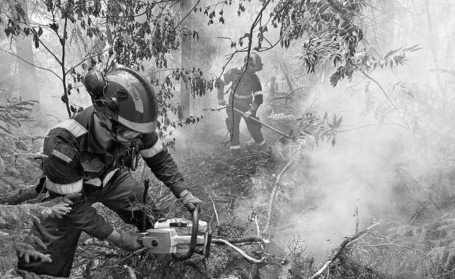US blanketed again by smoke from Canadian fires

Dense smoke and thick haze from Canada's wildfires that blanketed much of the East Coast earlier this month are again covering parts of the United States, particularly the Midwest, and moving eastward on Wednesday.
Air quality alerts were issued for parts of 17 states from Iowa and Minnesota in the west to New York, Maryland, Delaware and North Carolina in the east.
The alerts cover 80 million people, almost a quarter of the US population.
The New York City area joined the list, with an alert going into effect at midnight on Wednesday. New York State Governor Kathy Hochul warned that air quality is expected to reach unhealthy levels in parts of western and central New York on Wednesday and Thursday.
The present wildfires in Canada will likely result in poor air quality affecting parts of the US for a few days, the National Weather Service said. But the smoke is not forecast to linger or cause issues such as orange skies and the worst air quality in history that NYC and the northeast saw earlier this month.
Forecasters said this round of Canadian wildfire smoke is perhaps a bit less intense than the earlier one. Thick smoke and haze traveled southward along the East Coast, affecting areas from New York to Washington, and even reaching as far west as Minnesota.
By Tuesday, the fires had burned 7.8 million hectares. The fires are not expected to be extinguished either by firefighters or a major shift in weather conditions until after summer ends.
Smoke was thickest around the lower Great Lakes region and Ohio Valley on Wednesday afternoon, and that patch will continue to drift toward the east and southeast through Thursday, forecasters said.
Worst air quality
Chicago, Detroit and Minneapolis had the worst air quality globally on Tuesday and Wednesday, according to IQAir's Air Quality Index.
Cleveland, Pittsburgh, Milwaukee, Indianapolis and Iowa's Cedar Rapids saw code purple air quality on Wednesday morning, indicating very unhealthy conditions with an elevated health risk for the general public.
The wildfires are so intense that NASA said on Monday that its satellite imagery revealed the smoke had traveled across the Atlantic Ocean to Europe, drifting over parts of northern Portugal, Spain and France.
Wildfire season typically happens annually from May until October in Canada, home to about 9 percent of the world's forests. But this year's wildfire season has burned more square kilometers of land than in any other season in the past 40 years.

Today's Top News
- China, Japan, ROK urgently need an FTA
- From humanoids to parallel intelligence
- Shared wartime history unites nations, envoy says
- Mutual trust reaffirmed in visit
- 12 dead, 4 missing after bridge collapses in Qinghai
- Steps taken to boost domestic consumption






























